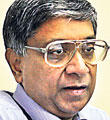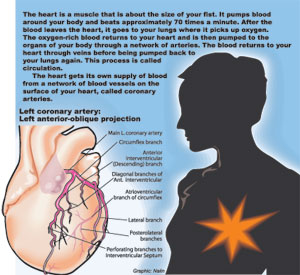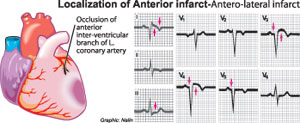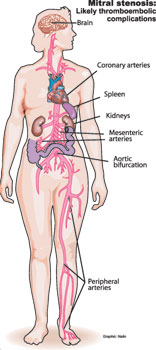Wife, mother, daughter, sister, professional and many more……..she plays all these roles to full capacity, but is it at a cost to her health?
How many women, especially those at the peak of their family life and careers who are in their 40s or 50s take stock of their health – undergo a blood-sugar test and do cholesterol and pressure checks?
Regular check-ups are essential, stresses Consultant Cardiologist Dr. Ruvan Ekanayaka, Head of the Institute of Cardiology, National Hospital for research worldwide, though no statistics are available for Sri Lanka, has proven that cardio-vascular disease is the No. 1 killer among women, moving away from infectious diseases and childbirth.
 |
| Dr. Ekanayaka |
More “sobering” thoughts on women and their hearts follow.
Although since 1979, the number of men who died of coronary heart disease (CHD) in the United States of America and Europe has reduced, the same good news is not valid for women, MediScene understands. The percentage of women dying of CHD has increased, with 52% not even reaching the hospital.
A build-up of fatty substances in the coronary arteries, due to various factors, could block or interrupt the blood supply to the heart, says Dr. Ekanayaka, explaining how CHD is caused. The narrowing of the coronary arteries will restrict the blood supply to the heart causing chest pains (angina) while a complete block will cause a heart attack or myocardial infarction.
Studies on all ethnic groups across the world including those in South Asia, MediScene learns, indicate that women become more vulnerable to CHD 10 years later than men, according to this Consultant Cardiologist. While men between the ages of 45-55 years are more prone to CHD, women are likely to become victims when they are in the 55-65 year age group.
For, women get protection from CHD up to that time from the production of the hormone, oestrogen, while they are menstruating which mitigates the risk factors. This protection, however, wanes with menopause.
The pre-menopausal two years are a danger period for women, cautions Dr. Ekanayaka, adding that this is the time the hormones begin to decrease.
How will a woman know? Like mother, like daughter, he points out, explaining that a woman will reach menopause around the same time that her mother did.In the light of menopause being a pre-disposing factor for heart disease in women, when asked whether hormone replacement therapy (HRT) will be the answer, Dr. Ekanayaka explained that there is no evidence to prove this.
To the contrary, studies have shown that the combination of hormones in HRT and their artificiality slightly increases the susceptibility to heart disease as do oral contraceptives. Both HRT and oral contraceptives increase coagulation (blood clotting) and in turn the possibility of a clot blocking a coronary artery, he says.
Delving into other heart issues, he says that the coronary arteries of women are also smaller (2.5-2.75mm) than those of men (2.5-3.5mm), creating serious repercussions even if there is a ½ mm reduction by the build-up of plaque. The impact is more because the block is worse and the prognosis not very good.
Pointing to a preventable cause, he says although Sri Lankan women in general do not smoke (smoking is a risk factor for CHD), they are compelled to become passive smokers because their husbands and colleagues do so in the closed environs of their homes and offices. Smokers should do so outdoors, he says, adding that in the west there are demarcated smoking areas to prevent exposure of non-smokers to hazardous tobacco fumes.
A metabolic factor why more women are dying of heart disease is linked to their X chromosome, MediScene understands. Usually, the ‘bad’ cholesterol (LDL – low density lipoprotein) in blood is attacked and eaten up by macrophages but X, which specifies the gender of a woman, affects this action. Macrophages are more active in men than in women, resulting in women being more vulnerable to plaque caused by bad cholesterol building up along arteries.
For women, as for men, the traditional risk factors are the same -- smoking, diabetes, hypertension or high blood pressure, obesity, high levels of bad cholesterol, lack of physical exercise, mental stress and, of course, the genetic predisposition or hereditary factor.
Singling out obesity, he says it varies from men to women. In women the fat usually settles on the gynaecoid areas of buttocks and thighs while in men it is on the waist, central obesity around the stomach or androidal.
Meanwhile, chest pains in most women are due to non-cardiac reasons but when they do get an ischaemic heart attack (triggered by an insufficient blood supply to the heart due to plaque build-up in the coronary arteries), it tends to be slightly more virulent than in men.
Lifestyle is also crucial now because more and more women have joined the rat race as opposed to those days when they managed their homes. Women are multi-tasking, they are under stress and strain, says Dr. Ekanayaka, urging them to undergo regular tests to catch any signs of heart disease early.
Few indicators whether your heart may be heading in the wrong direction:
- An average woman’s waist should be 80cm while it is 90cm for a man – a bigger waistline will be an indicator of obesity and excessive weight.
- The ideal weight of a woman who is 5’ tall should be 120 pounds, increasing or decreasing by four pounds for every inch going up or down resepctively.
- The calorie-intake of a sedentary woman should be a total of 1,200-1,600 calories per day. “If one burger meal amounts to that she has taken her total for the day,” smiles Dr. Ekanayaka, adding that liberal servings of fruit and vegetables should be eaten. Hunger should be appeased by salads.
- Usually women have high levels of ‘good’ cholesterol (HDL – high density lipoprotein) as opposed to LDL while men have lower levels of HDL. The acceptable level for a woman should be more than 50mg/dL and for men up to 50mg/dL.
- Exercise is very important – a 30-minute brisk walking session with five such sessions a week. Sweeping, household chores etc provide mere physical fatigue but not aerobic exercise, says Dr. Ekanayaka, advising that it is also better to exercise at home or in a gym because it is a cleaner environment. “The outside air is polluted with diesel fumes and particulates which can cause arterial dysfunction which in turn can lead to heart disease.”
- Relaxation is vital. While yoga and meditation may be relaxing, women may not have much energy to engage in these activities. However, there is a simple solution – listen to music in your own home. This is both relaxing and enjoyable, says Dr. Ekanayaka, explaining that studies conducted by Oxford University have proven the benefits of musicotherapy. And the most relaxing music seems to be the ragas and western classics such as Bach. Four to five minutes of such music not only helps the respiratory and pulse rate but also brings down blood pressure.
Rheumatic heart disease still
common
Women have to be careful about rheumatic heart disease which involves the valves in the heart, urges this Consultant Cardiologist, with doctors at his unit being perturbed over the number of new patients they see every month.
As a country’s socio-economic status improves, there is a decrease in rheumatic heart disease, it is learnt, with this illness being non-existent in the United Kingdom and Europe.
“We thought it would be similar in Sri Lanka, but every month we see 10-15 new patients in the child-bearing age with mitral stenosis,” says Dr. Ekanayaka. In this disorder, the mitral valve which separates the upper and lower chambers on the left side of the heart does not open fully restricting the flow of blood.
Serious note should be taken of throat infections in children in the age-group 5-15, culture tests taken and treatment begun to prevent the development of rheumatic heart disease later, he adds.
The women:men ratio with mitral stenosis is 6 to 1. |





